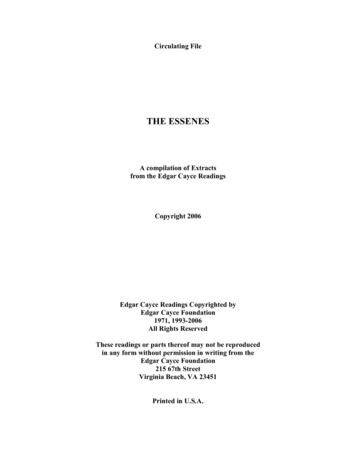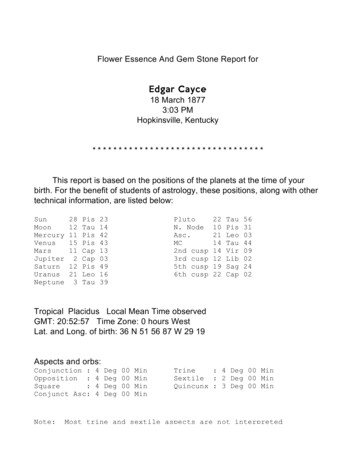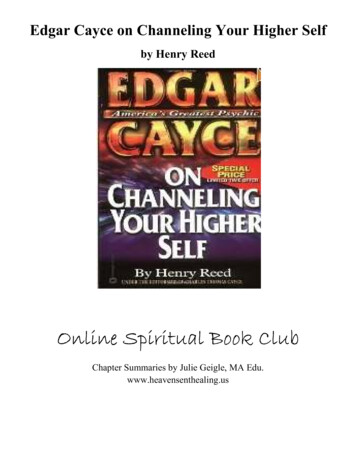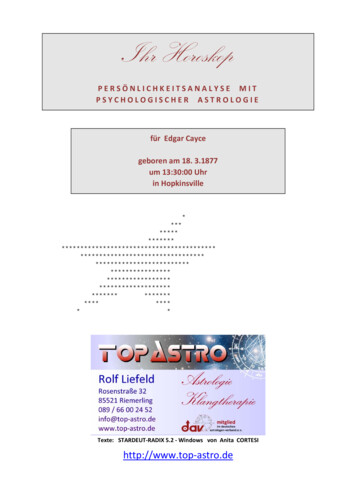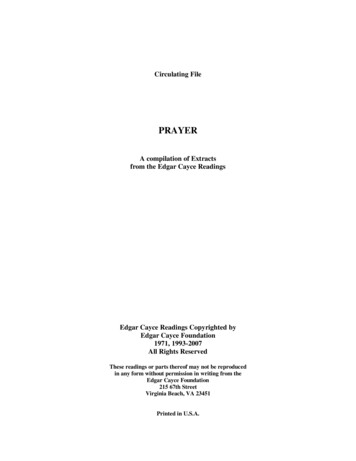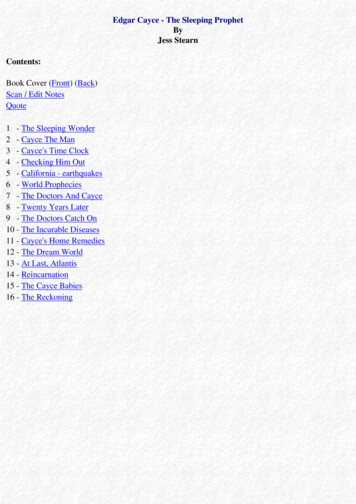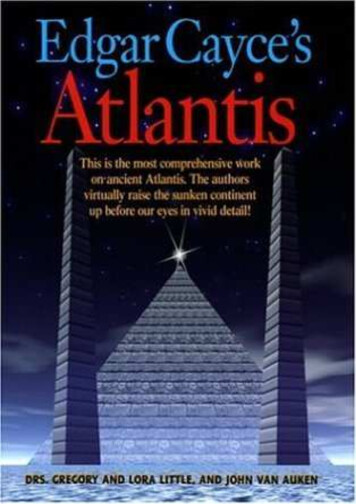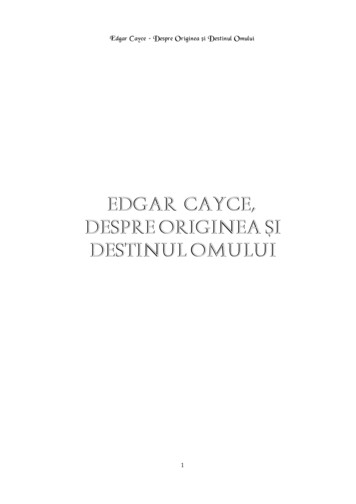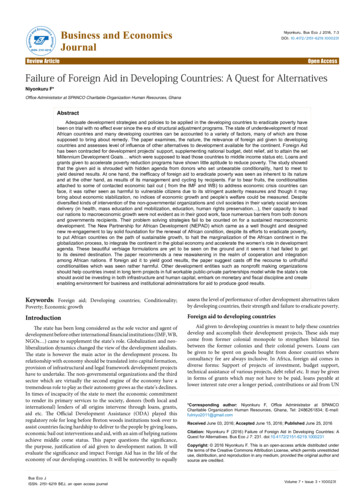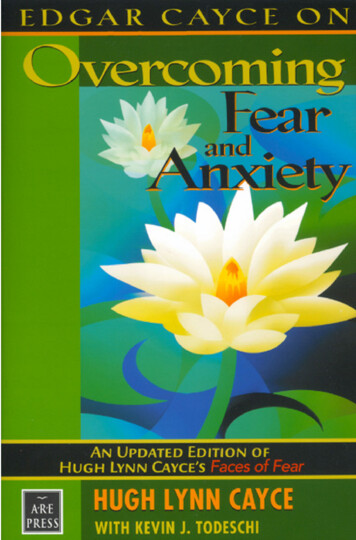
Transcription
EDGAR CAYCE ONOvercoming Fearand Anxiety
E D G A R C AY C E O NOvercoming Fearand AnxietyAn Updated Edition ofHugh Lynn Cayce’sFaces of FearHUGH LYNN CAYCEWITH KEVIN J. TODESCHIA.R.E. Press Virginia Beach Virginia
Copyright 2004by Kevin J. TodeschiFaces of Fear 1980 by Hugh Lynn Cayce4th Printing, April 2012Printed in the U.S.A.All rights reserved. No part of this book may be reproduced or transmitted in any form or by any means, electronic or mechanical, including photocopying, recording, or by any information storage andretrieval system, without permission in writing from the publisher.A.R.E. Press215 67th StreetVirginia Beach, VA 23451-2061Library of Congress Cataloguing-in-Publication DataCayce, Hugh Lynn.Edgar Cayce on overcoming fear and anxiety : an updated edition ofHugh Lynn Cayce’s Faces of fear / by Hugh Lynn Cayce with Kevin J.Todeschi.p. cm.Includes bibliographical references (p.).ISBN 0-87604-494-1 (trade pbk.)ISBN 13: 978-0-87-04-494-01. Parapsychology and medicine. 2. Fear—Alternative treatment. 3.Anxiety—Alternative treatment. 4. Cayce, Edgar, 1877-1945. 5. Fear. 6.Anxiety. I. Todeschi, Kevin J. II. Cayce, Hugh Lynn. Faces of fear. III.Title.BF1045.M44C39 2004131—dc222004020201Edgar Cayce Readings 1971, 1993-2007by the Edgar Cayce Foundation.All rights reserved.Cover design by Richard Boyle
ContentsForeword . ixONE:The Nature of Fear .1TWO:Are Our Bodies Afraid? . 11THREE: Repressed Fear Memories . 29FOUR:Fears from Past-Life Memories . 43FIVE:The Fear of Death . 55SIX:Reexamining Your Fears and Anxieties . 67SEVEN: Bringing Your Life into Alignment—Spiritually . 73EIGHT: Bringing Your Life into Alignment—Mentally . 97NINE:Bringing Your Life into Alignment—Physically .121TEN:The Oneness of All Force . 127Conclusion . 135Appendix A: Fear Questionnaire: Getting in Touch with Possible Causesfor Personal Fears . 139Appendix B: Bringing All Things to Your Remembrance . 145Appendix C: References and Recommended Reading . 151
The Lord is my light and my salvation; whom shall I fear?The Lord is the strength of my life; of whom shall I be afraid?Psalm 27:1
ForewordTHERE WAS a time when I was so terrified of speaking in front ofindividuals that I rarely—if ever—forced myself to even ask aquestion while in a group of three or more people. Except on afew occasions when I felt extremely comfortable around friends or family, I never spoke in a group and I never raised my hand in a class.When I was called on or I was forced to speak, the fear became sointense that I felt my throat constrict and grip with fear. While thisoccurred, breathing was next to impossible and my face would becometight and hot. Any words that did manage to escape my mouth wereforced out between uneven breaths. If individuals turned to look at meas I struggled to speak, it felt as if I was strangling, choking on thewords that became stuck in my throat and I would turn red-faced withembarrassment. Over the years, I became angry with myself for beingso afraid and I became even more afraid of situations in which I mightbe called on to speak in front of people.Today, it is almost hard to imagine being crippled by such intensefear. As a spokesperson for the work of Edgar Cayce, I have lectured inix
front of literally tens of thousands of individuals on five continentsregarding dozens of topics. I have given dream interpretation classes inEcuador, spoken about ancient Egypt in Japan, held intuition workshops in France, escorted numerous tour groups along the Nile, ledhypnotic reveries in Canada and given hundreds of lectures throughout the United States—from California in the West and Washington D.C.in the East, and from Texas in the South and Montana in the North. Thefearful student who would not even raise a hand in class could neverhave conceived of such a possibility.I still remember what year I began to overcome the fear, and I clearlyremember the occasion that caused me to think beyond any doubt, “Ihave got to do something about this.” It was 1982 and I was an attendeeat a retreat program in the mountains of Colorado. The speaker was Dr.Gladys McGarey, M.D., author of Born to Live and one of the foremostauthorities of the Cayce principles of health, healing, medicine, and childrearing. Dr. Gladys, as she is affectionately known, was speaking abouther many experiences during thirty-plus years as an obstetrician. I remember it was a wonderful program with about eighty of us in attendance.As she spoke, there was a question I wanted answered that I hopedshe would simply discuss. Unfortunately, she did not. As the lecturecame to an end and Dr. Gladys opened the conference up for questions,I hoped that someone else would ask the question that I wanted toknow. One question followed after another, each being answered inturn, but no one voiced the query that I had hoped to hear. My question was as follows: I had heard that the Edgar Cayce readings suggested whenever a child was born into the earth, the angelssang—joyously proclaiming the opportunity for spirit to enter into theearth. I wanted to know if during her many years as an obstetrician, Dr.Gladys had ever heard the music of angelic voices. That was my question, however it was a question that no one else asked.As it became clear to me that the conference session was coming to aclose, my desire to know the answer to this question became strongerthan the fear of raising my hand. Feeling I had absolutely no otherchoice than to ask the question myself, I repeated the question in myhead four or five times to reassure myself. When I had finally workedx
up the nerve, I raised my hand.Immediately, Dr. Gladys called on me. I can remember sitting thereready to ask the question that I had repeatedly verbalized in my headwithout any problem. Suddenly, I saw three or four other confereesturn to look at me as I began to speak. Immediately, I felt my throatconstrict, my face turned red, and without breathing I somehow managed to choke out a dozen words that barely provided Dr. Gladys withjust enough information to know what I was really trying to ask. Evennow, I can remember feeling ashamed as Dr. Gladys responded to myquestion, wondering how many other people had seen my public display of fear.Synchronistically, a few weeks after the conference I had the opportunity to obtain a psychic reading from an intuitive named WilliamSchaeffer, who was living in Denver at the time. Without thinking aboutmy fears or worries, I went to William for a past-life reading. Williamand I had never met before; he knew nothing about my personal life,my hopes, my dreams, or my fears. The experience proved to be a turning point for me.During the session, William said that one of the challenges I had toovercome in the present was a deep-seated “intolerance of intolerance.”He went on to say that oftentimes in my soul’s history I had gotten “upon a soapbox” to tell people about how mistaken they were in theirshortsighted beliefs, their biases, and their prejudices. According to William, rather than enabling individuals to broaden their perspectives,more often than not my approach had simply gotten me “arrested,shunned, or even hanged.” He added: “You know every time you get upto speak to people, your subconscious mind thinks, ‘Oh no, here hegoes again . . . shut him up.’” To emphasize his point, William made ahangman’s noose with his fingertips and constricted the circle with hishands. At that moment, I believed I had found the cause of my fear.To be sure, the fear did not immediately come to an end. Instead,what happened was that each time I found myself in a situation were Ineeded to speak before a group, I would reassure myself with positiveaffirmations, such as: “I have nothing to fear, I am just asking a question”; “these people want to hear what you have to say”; “there is noreason to worry, I am in a safe place,” and so forth. At first, the fear wasxi
no longer crippling. Eventually, it became manageable. In time, I workedthrough it. William’s brief statement became the catalyst that enabledme to overcome the fear that had impacted my life for as long as I couldremember. Speaking in public was not my only fear, but it was certainlyone of the most overwhelming.Edgar Cayce (1877-1945), who has been called one of greatest psychicsof all time, suggested that fear is one of the biggest stumblingblocksindividuals face throughout their lives. Fear can be crippling; it cancause individuals to refrain from doing what they know to do and frombecoming what they were meant to be. Fear comes in a variety of intensities and it seems to have a number of causes. Every individual has hadto face fear at one time or another. It is the cause of fear and how werespond to that fear that sets us apart as individuals.Throughout his life, Edgar Cayce helped countless individuals overcome every imaginable fear: fear of water, fear of ghosts, fear of theunknown, fear of failure, fear of childbirth, fear of closed-in places, fearof sex, fear of relationships, fear of weapons—every imaginable personal fear. Somehow, in his trance state, Cayce was able to get to theroot cause of an individual’s fear and consistently provide each personwith a practical approach for overcoming fear, anxiety, and worry. In avery real sense, this information has touched the lives of thousands—not only those individuals who had readings from Edgar Cayce but alsothose who came after Cayce was gone and were simply able to explorethe material for themselves.Because fear is universal, Edgar Cayce’s eldest son, Hugh Lynn Cayce(1907-1982), decided to publish a book in 1980 entitled Faces of Fear thatdetailed his many years of working with his father’s information, assisting individuals in overcoming their personal anxieties and fears. Thebook contained many of Hugh Lynn’s experiences overcoming his ownfears. I first read Faces of Fear in 1982, shortly after my encounter withWilliam Schaeffer. Hugh Lynn’s volume proved to be extremely helpfulin my own life. So helpful, in fact, that I never forgot it—I rememberedmuch of the information even years after the volume had gone out ofprint.Based upon on his years of experience, Hugh Lynn believed that allfears could essentially be traced to five different sources. Although somexii
fears might have more than one cause, Hugh Lynn believed that thefive major sources of fear were as follows: Fears due to a physical situation or problem Repressed fears from childhood Fears of religion or God Fears of death or the unknown Fears due to a past-life experienceHugh Lynn’s Faces of Fear would become for him one culmination ofhis decades of working with his father’s psychic information. He delighted in talking about the book, in leading lectures and workshopsabout the information, and in providing individuals with tools theycould utilize to overcome their own fears and anxieties. Unfortunately,the volume would be Hugh Lynn’s last publication; he died from complication of cancer at the age of seventy-five on July 4, 1982.Hugh Lynn’s book was not my first experience with him. In fact,years before even graduating from college I had received a letter fromhim. At the time, I had written him, describing my deep interest in theEdgar Cayce information. I had long heard his name, first as his father’sson, then as the general editor of a series of Warner paperbacks (the“Edgar Cayce on . . . ” series) written in the late 1960s, and finally as headof the Association for Research and Enlightenment, Inc.—A.R.E., the organization founded by Edgar Cayce in 1931 to preserve, research, anddisseminate his psychic information.Imagine my surprise when, as a young man, I received a personalletter with the return address of Hugh Lynn Cayce, “A.R.E. Chairman ofthe Board.” Hugh Lynn encouraged me to look him up when I came toVirginia Beach—something I eventually did. Years later, I discovered thatHugh Lynn’s reaching out to me was not an isolated event. He oftenwent out of his way to encourage young people to become more involved with his father’s work and information.It is important to point out that any book or publication writtenabout Edgar Cayce and the Cayce information before the widespreaduse of computers was not an easy undertaking. When Hugh Lynn wasalive, researching the Cayce readings could be a painstaking experience, sifting through literally hundreds or even thousands of pageslooking for a certain quote or a particular case history. It was a processxiii
that could take days, weeks, or even months. The advent of the Caycereadings on CD-ROM in the 1990s made a manual search of the Caycefiles a thing of the past. Individual words and phrases contained withinthe more than 14,000 readings could be discovered in an instant. In avery real sense, Hugh Lynn Cayce and those who knew Edgar Caycepersonally did not have access to the Cayce information in ways thatwe do today.As the years passed and I began to see how many others were affected by a variety of fears, I remembered how very helpfu
Edgar Cayce (1877-1945), who has been called one of greatest psychics of all time, suggested that fear is one of the biggest stumblingblocks individuals face throughout their lives. Fear can be crippling; it can cause individuals to refrain from doing what they know to do and from becoming what they were meant to be. Fear comes in a variety of inten- sities and it seems to have a number of .
